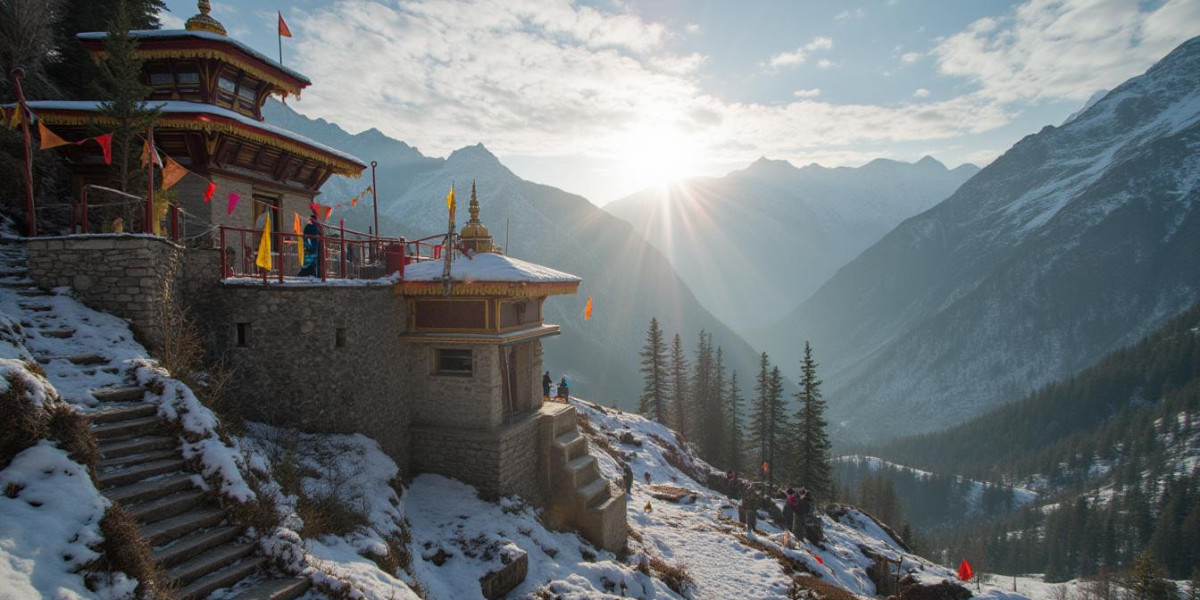Shakti Peethas in Himachal Pradesh: A Devotee’s Ultimate Pilgrimage Circuit
India’s cultural and spiritual heritage is deeply rooted in its temples, myths, and ancient traditions. Among these, the Shakti Peethas hold a unique place, being the sacred shrines dedicated to Goddess Shakti. They are scattered across the Indian subcontinent, with each site connected to the legend of Goddess Sati. Himachal Pradesh, often called “Dev Bhoomi” or the Land of Gods, is home to some of the most revered Shakti Peethas, making it a divine destination for pilgrims and spiritual seekers.
This blog explores the significance, legends, and pilgrimage circuit of the Shakti Peethas in Himachal Pradesh. Whether you are a devotee seeking blessings, a traveler interested in culture, or a spiritual enthusiast, this journey through Himachal’s divine landscapes promises both faith and fulfillment.
The Legend of Shakti Peethas
The origins of the Shakti Peethas date back to one of the most powerful legends in Hindu mythology — the story of Goddess Sati and Lord Shiva. Sati, the daughter of King Daksha, immolated herself in protest against her father’s insult to Lord Shiva. Distraught, Shiva carried her body across the world, performing the Tandava (the cosmic dance of destruction). To calm Shiva’s grief, Lord Vishnu used his Sudarshan Chakra to dismember Sati’s body. Wherever her body parts fell, a Shakti Peetha was established.
In total, there are 51 to 108 Shakti Peethas mentioned in different scriptures, each symbolizing a divine energy center. Himachal Pradesh, with its mountainous terrain and aura of sanctity, is believed to house several of these sacred shrines, making it a vital region in the pilgrimage map of Shakti worshippers.
Shakti Peethas in Himachal Pradesh
The Shakti Peethas in Himachal Pradesh are not only centers of devotion but also represent cultural richness, architectural beauty, and spiritual strength. Among the most prominent are:
1. Naina Devi Temple (Bilaspur)
One of the most famous Shakti Peethas, the Naina Devi Temple is located in Bilaspur district. It is believed that the eyes of Goddess Sati fell here, which is why the temple is named after her eyes (Naina). Situated on a hilltop overlooking the Gobind Sagar Lake, the temple attracts thousands of devotees during the annual fairs and festivals, especially Navratri. The temple is also historically linked to Raja Bir Chand, who is said to have founded it in the 8th century.
2. Chintpurni Temple (Una)
Dedicated to Goddess Chhinnamastika, the Chintpurni Temple is revered as the place where Sati’s feet are believed to have fallen. The name “Chintpurni” literally means “the remover of worries,” and devotees believe that the Goddess fulfills wishes and relieves them from life’s burdens. The temple’s fairs during Shukla Ashtami and Navratri are major attractions for pilgrims.
3. Jwala Ji Temple (Kangra)
The Jwala Ji Temple is among the most unique Shakti Peethas in Himachal Pradesh, where Sati’s tongue is believed to have fallen. What makes this temple extraordinary is the presence of an eternal flame that burns continuously without fuel. Devotees see this as the living presence of the Goddess. Historical figures like Akbar the Great are said to have visited this temple, adding to its legacy of reverence and awe.
4. Chamunda Devi Temple (Kangra)
Located on the banks of the Baner River, the Chamunda Devi Temple is dedicated to Goddess Chamunda, a fierce form of Durga. It is believed that the temple marks the spot where Sati’s hair fell. This temple is unique because it combines devotion with scenic beauty, offering views of the Dhauladhar mountain ranges. Devotees also perform rituals here for their ancestors, making it a site of both worship and remembrance.
5. Brajeshwari Devi Temple (Kangra)
One of the most significant temples in the Shakti circuit of Himachal Pradesh, the Brajeshwari Devi Temple is associated with the place where Sati’s breasts are believed to have fallen. Known for its grand celebrations during Lohri and Navratri, the temple is an epitome of resilience as it has been rebuilt multiple times after invasions and natural calamities. Today, it stands as a symbol of devotion and strength.
6. Laxmi Narayan Temple Circuit (Chamba)
While not directly one of the 51 Shakti Peethas, the Laxmi Narayan Temple in Chamba complements the spiritual journey of devotees in the region. Many pilgrims visiting the Shakti Peethas extend their circuits to Chamba to witness the temple’s intricate architecture and divine aura.
The Pilgrimage Circuit
Undertaking the journey across the Shakti Peethas in Himachal Pradesh is more than a religious act; it is a spiritual transformation. Most devotees start their pilgrimage from Naina Devi Temple and move on to Chintpurni, Jwala Ji, Chamunda Devi, and Brajeshwari Devi. The circuit can be completed within a week, though many take longer to immerse themselves in the rituals and local traditions.
Each temple is connected by well-maintained roads, and the Himachal government has also improved facilities for pilgrims. During Navratri, these sites witness a surge in visitors, turning the circuit into a vibrant blend of devotion, music, and community spirit.
Cultural and Spiritual Importance
The Shakti Peethas in Himachal Pradesh are not just places of worship; they are cultural landmarks that preserve ancient traditions. Folk songs, local dances, and fairs associated with these temples enrich the cultural identity of the region. They also serve as reminders of the deep bond between human devotion and nature, as most temples are nestled in scenic mountains, forests, or riversides.
For devotees, visiting these temples is a way to reconnect with the divine feminine energy, believed to bring strength, prosperity, and spiritual awakening. For travelers, these temples provide insight into India’s spiritual diversity and the enduring power of faith.
Travel with Adotrip
Planning a pilgrimage to the Shakti Peethas in Himachal Pradesh can be overwhelming, given the number of temples, travel routes, and seasonal factors to consider. This is where Adotrip comes in as a trusted travel partner. With curated packages, comfortable accommodations, and local insights, Adotrip ensures that your spiritual journey is smooth, meaningful, and memorable. Whether you want a short temple tour or a complete week-long pilgrimage circuit, Adotrip can customize your itinerary to match your preferences.
Tips for Pilgrims
Plan your visit during Navratri or other major festivals to experience the vibrant atmosphere.
Carry comfortable clothing and footwear, as many temples are located on hilltops requiring short treks.
Respect local customs and temple rituals, as they are integral to the spiritual experience.
Opt for trusted travel partners like Adotrip to handle logistics, leaving you free to focus on your devotion.
Conclusion
The Shakti Peethas in Himachal Pradesh are not just temples; they are gateways to divine energy, legends, and centuries of unwavering devotion. Each shrine holds a piece of mythology, a spark of spirituality, and a blessing for every pilgrim. From the eternal flame of Jwala Ji to the serene vistas of Chamunda Devi, these temples form a sacred circuit that is both spiritually uplifting and culturally enriching.
For those seeking not just a journey but a transformation, embarking on this pilgrimage is an experience of a lifetime. With Adotrip as your guide, the path to divine connection becomes even more fulfilling.
Frequently Asked Questions (FAQ)
1. How many Shakti Peethas are there in Himachal Pradesh?
Himachal Pradesh is home to five prominent Shakti Peethas — Naina Devi Temple, Chintpurni Temple, Jwala Ji Temple, Chamunda Devi Temple, and Brajeshwari Devi Temple. These temples are part of the larger Shakti Peetha network across India and hold immense spiritual significance for devotees.
2. What is the significance of the Shakti Peethas in Himachal Pradesh?
The Shakti Peethas in Himachal Pradesh are believed to mark the spots where parts of Goddess Sati’s body fell. They are sacred centers of divine feminine energy, symbolizing strength, devotion, and spiritual awakening. Visiting these temples is seen as a path to blessings, prosperity, and liberation.
3. Which is the most visited Shakti Peetha in Himachal Pradesh?
All temples attract large numbers of devotees, but Jwala Ji Temple, famous for its eternal flame, and Naina Devi Temple, located on a scenic hilltop, are among the most visited. During Navratri, these temples see a massive influx of pilgrims from across India.
4. What is the best time to visit the Shakti Peethas?
The best time to plan your pilgrimage is during the Navratri festivals, celebrated twice a year (March–April and September–October). However, the temples are open throughout the year. Summer months (April–June) offer pleasant weather, while winters (November–February) provide a serene spiritual atmosphere.
5. How can I travel to the Shakti Peethas in Himachal Pradesh?
The Shakti Peethas are well-connected by road from major cities like Chandigarh, Delhi, and Shimla. Pilgrims often follow a circuit route starting from Naina Devi and covering Chintpurni, Jwala Ji, Chamunda Devi, and Brajeshwari Devi. Adotrip offers curated pilgrimage packages to make travel easier and more convenient.
6. Are accommodations available near the temples?
Yes, accommodations are available near all the major temples. Pilgrims can choose from dharamshalas, budget hotels, and mid-range lodges. For those seeking a comfortable experience, travel partners like Adotrip can arrange premium stays closer to the pilgrimage sites.
7. What rituals are performed at the Shakti Peethas?
Rituals at the Shakti Peethas include daily aarti, special pujas during Navratri, and offerings of flowers, prasad, and coconuts. Many devotees also perform havans and ceremonies for ancestors, especially at Chamunda Devi Temple.
8. Is trekking required to reach these temples?
Some temples, such as Naina Devi, require a short trek or the use of a ropeway, while others like Chintpurni, Jwala Ji, and Brajeshwari Devi are accessible by road. Comfortable walking shoes are recommended for devotees.
9. Can non-Hindus visit the Shakti Peethas?
Yes, the Shakti Peethas in Himachal Pradesh welcome all visitors, irrespective of religion, who come with respect and devotion. However, visitors are advised to follow temple customs and dress codes while entering the premises.
10. Why should I plan my pilgrimage with Adotrip?
Adotrip provides seamless travel experiences with customized itineraries, comfortable accommodations, and local guidance. By planning your pilgrimage with Adotrip, you can focus on your spiritual journey while leaving logistics like transportation and hotel bookings in expert hands.







